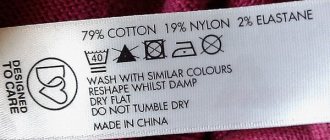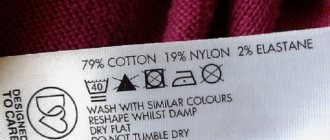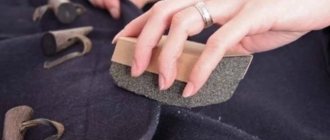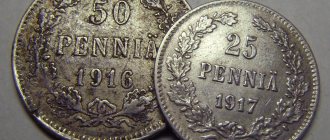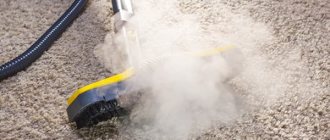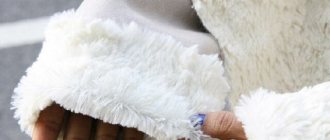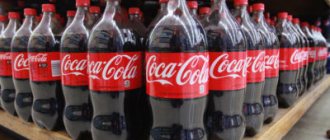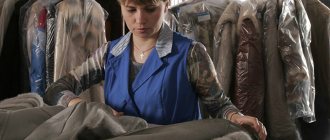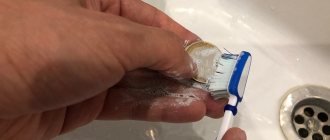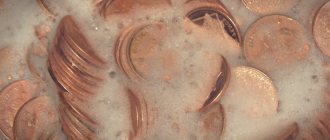Dry cleaning of a down jacket is a local cleaning of dirt or stains without the use of hand or machine washing.
This option for getting rid of dirt allows you to quickly get a clean down jacket or jacket, saving time on drying.
In addition, dry cleaning does not affect the entire down jacket, as happens during washing. This allows you to extend the life of the product. In this article we will look at the process of dry cleaning a down jacket at home without washing.
Definition
Dry dry cleaning of clothes is a method of cleaning clothes from stains using products that do not need to be dissolved in water. With this method, no liquid is used. The advantage of the procedure is the protection of products from fabric deformation, which cannot be achieved with regular washing.
Manufacturers usually mark washing instructions on clothing. But these tips are not always helpful or may be difficult for people to follow. Dry cleaning your clothes makes it easy to get the job done at home. It is necessary to control the entire process so that the products retain their appearance.
How to clean the fur parts of a jacket?
To decide on the fur cleaning method, you should find out whether it is artificial or real .
The first option can be easily cleaned with shampoo or soap. Simply dilute the product in water and dip the contaminated fur into it. It is lightly rubbed and then rinsed. After drying, the fur should be combed.
A natural product is cleaned differently:
- vinegar is mixed with water;
- Dip a sponge into the resulting solution and wipe the fur with it.
What items is the treatment suitable for?
What products can be dry cleaned? Delicate fabrics include:
- Silk.
- Wool.
- Fine cotton and linen.
- Thin knitwear.
- Velvet.
- Suede and leather.
If clothes have complex decorative details, for example, hand embroidery with beads, sequins, rhinestones, then they are damaged when processed in a machine, even if a delicate mode is used. The home dry cleaning procedure perfectly preserves the appearance of things. This kind of work should also be done in cases where you want to extend the life of your favorite item. With this processing there is no need to remove buttons, belts, shoulder pads and other parts.
Tips and warnings
In order not to make a mistake in choosing the type of fabric treatment, you need to read the information on the label.
If dry cleaning is indicated there, then you should not experiment with liquid, because the manufacturer believes that this method can extend the life of the product. Machine washing in the wrong mode and aggressive drying with warm air, which leads to overdrying, significantly reduce the lifespan of items. Products with lace, beads and embroidery cannot be machine washed as they will lose their original appearance. Even if the main fabric is cotton, washing such items is prohibited. Rigid materials can also be dry cleaned, as exposure to water can damage their texture.
The correctly chosen option for cleaning the material can not only remove the stain, but also make things look beautiful again.
How is the procedure performed?
Dry cleaning is performed based on the following steps:
- Things should be placed in a special bag or case. Clothes should lie loosely. Delicate items are turned inside out in advance.
- Place wet and scented wipes in the bag. The moisture contained will allow cleaning to take place. Due to the humid environment, things do not wrinkle.
- You need to turn on the drying mode in the machine. You should set a timer for 30 minutes. The temperature should be minimal.
- After cleaning, hang the clothes on hangers to maintain their shape.
Stages of execution in laundries
There are 5 main stages of processing textiles, leather and other materials:
- Initial appointment. The stage includes an external inspection, determination of the acceptable processing method and the level of contamination. Then a contract is concluded with the client.
- Distribution. Produced by sorting items with the same dry cleaning icon recommendations on clothing.
- Pre-removal of stains. The main goal is to clean the dirtiest areas to improve the quality of subsequent processing of products. Detergents and solvents are used to remove stains. Work tables are equipped with local light sources and devices for supplying hot steam.
- Basic cleaning operation. After preliminary preparation, things are placed in machines to completely remove all existing contaminants. The stage ends with drying at temperatures up to 60°C.
- Finishing procedures. The finishing process includes ironing using presses or on mannequins. Then a visual inspection is carried out to assess the quality and the items are packaged ready for delivery. If defects are detected, the dry cleaning process is repeated.
Washing machines operate on a closed cycle principle, during which used solvents are sent to special devices for distillation in order to get rid of impurities. After washing, things are dried, and solvent evaporation is captured by special devices - adsorbers. Modern chemical processing methods and a high level of equipment in laundries provide environmentally friendly and safe working conditions for workers.
Facilities
Dry cleaning is often necessary for delicate materials, such as silk, wool, and fine cotton. Many items can be washed using the “Delicate Wash” mode. For example, clothes made of linen, viscose, triacetate.
If the dry method is chosen, then the work can be done using special chemicals or natural ones. They can be purchased at many household chemical stores or found at home. Most of them are easy to use and affordable.
Why 100% dry cleaning results are not guaranteed even by a professional master
A good furniture dry cleaner knows what products need to be used to remove different types of stains and how materials react to different chemical components. But this knowledge does not always help to obtain the expected result.
What difficulties may arise:
► The contamination has a mixed composition (for example, wine + blood + coffee with milk + brilliant green). To remove complex stains, you need different stain removers, which may react “not in the best way” when interacting.
► The stain was “placed” a long time ago. Over time, contaminants become fixed in the structure of the material, and their composition changes. For example, a protein gradually polymerizes to form a water-insoluble substance.
► The old stain mixed with other stains and became difficult to “identify”. In this case, craftsmen have to test different products at random.
► There are other contaminants in the filler under the upholstery that are not visible on the surface. When you try to wash a stain with water, hidden contaminants may appear on the material.
► The filler contains natural tannin-containing materials - for example, coconut fibers. When such materials come into contact with water, brown halos may appear on the upholstery, which become fixed when interacting with alkaline agents.
The result of dry cleaning a sofa depends on the “age” and composition of the stain, as well as the type of material and filling.
What the sofa owner should know before cleaning it themselves:
► Manufacturer’s recommendations for cleaning upholstery material – is it safe from mechanical impact, can solvents be used, how does it react to water, etc.
► Filler composition – whether there are materials made from natural fibers containing tannins.
Return to contents
Read the blog: “5 reasons to agree to turbo drying after dry cleaning a sofa or carpet.”
Hagerty: DryCleanerKit
This dry cleaning kit makes it easy to get great results. The composition contains active substances that can eliminate various stains. It also contains components that refresh the material. The products included in the kit are used for drying in a washing machine.
This stain remover is necessary for cleaning fabrics without harsh solvents, since they are not contained in the composition. The procedure makes clothes fresh, after which the material does not shrink or stretch. The fabric retains its attractive appearance. The set is suitable for processing linen, cotton, silk and wool products.
Symbols on textile labels
Dry cleaning marks on labels contain information about the processing methods approved for a given material. Let's take a closer look at what the letters “P” and “W” in a circle mean and what other interpretation of the icons on clothing labels can be useful for washing and cleaning. According to the international standard, a number of specific symbols are currently used, each of which contains information about a particular method of caring for clothing.
Basic principles of decryption:
- circle – a sign with information about acceptable methods of cleaning the product;
- a letter icon in a circle means that you can use a solvent: “P” – perchloroethylene, “F” – flammable, “W” – water;
- crossed out circle – icon prohibiting dry or wet dry cleaning;
- one line under the circle – delicate processing mode;
- two lines under the circle - maximum gentle cleaning.
The table provides a detailed list of badges on clothing. Dry cleaning is carried out taking into account the recommendations for a specific product.
| Professional dry-cleaning in: perchloroethylene, hydrocarbons (heavy gasolines) | |
| The icon indicates that professional dry cleaning is permitted with any solvents, including heavy gasolines and perchlorethylene. | |
| Professional dry-cleaning in: perchloroethylene, hydrocarbons (heavy gasolines) | |
| The dry cleaning sign on the clothing label indicates the need for gentle treatment of the product with any ingredients. | |
| Professional dry-cleaning in: hydrocarbons (heavy gasolines) | |
| Professional dry cleaning icon for flammable hydrocarbons (heavy gasoline) | |
| Professional dry-cleaning in: hydrocarbons (heavy gasolines) | |
| Mild treatment with hydrocarbon compounds with high boiling points | |
| Do not dry-clean | |
| The icon on the tag prohibits the use of solvents. Clothing fabrics should not be dry cleaned | |
| Professional wet-cleaning | |
| Professional water cleaning | |
| Mild professional wet-cleaning | |
| Delicate wet cleaning mode | |
| Very mild professional wet-cleaning | |
| The most gentle way of water cleaning | |
| Do not wet-clean | |
| The icon on the label indicates that wet cleaning is prohibited, dry cleaning only! |
Natural remedies
There are fabrics that cannot be treated with chemicals. They should not be washed, but dry cleaning is quite suitable for getting rid of various types of dirt. If you are sensitive to household chemicals, you can use the following products:
- Scotch. It is great for leather items. It will remove new and old stains.
- Baking soda. The product is considered a natural absorbent that absorbs dirt. The advantage of using it is the availability of soda.
- Starch. The product allows you to remove dirt from clothes.
- Brush. It can be used to clean suede products.
- Sand. Used in the processing of fur products. Heated sand is poured onto the problem area. Then the remains must be shaken off.
- Petrol. Allows you to remove dirt. It is needed to remove serious stains, but due to the strong smell, it should only be used in extreme cases.
- Hydrogen peroxide. The product is considered a natural solvent. It is great for cleaning white items.
- Ammonia. It can remove all stains. It is not used undiluted; ammonia solution is usually used.
- Acetic acid. The concentrated product perfectly refreshes clothes.
Do-it-yourself dry cleaning at home should be done carefully. Before using any product, you must read the instructions. If natural ingredients are used, you should be patient as it will take time to remove the stains. If you are afraid of ruining the item, it is better to contact a specialist. Specialists will perform the procedure with the appropriate product selected based on the type of material.
Cleaning process
Chemicals
At home, do-it-yourself cleaning is carried out using chemical compounds. These include stain removers in the form of gel, powder, spray or wet wipes.
The following special compositions for dry cleaning at home can be mentioned:
- - SpotRemover. The gel comes with a brush for easy use, suitable for colored and white items. Helps remove traces of sweet liquids and fat.
- — gel “Minutka” for dry cleaning of dirt. Directions for use: Apply to fabric, wait for the product to dry and brush off any remaining residue.
- - Woolite. The product is intended for wool and knitwear; it is not recommended to use on items that shed.
- — Hagerty: Dry Cleaner Kit. Designed for cleaning silk, wool, cotton and linen.
- — K2r in the form of a spray. The product will help if you need to urgently remove a stain from an item.
Important: when cleaning, you do not need to use water, since professional products contain components that can independently remove dirt
Folk remedies for removing stains
To achieve results, folk remedies often need to be used several times in a row.
Scotch
Helps remove dirt from leather products. To do this, you need to apply the adhesive side of the tape to the dirt and tear it off.
Important : if the leather item is in poor condition, it is not recommended to use tape
Iron
The iron will help remove traces of oil, such as vegetable or machine oil. It is necessary to cover the contamination with paper or a paper napkin from the outside and from the inside. Heat the iron and run the surface over the stain. As the butter melts, it will be absorbed into the paper napkin.
Baking soda
Soda is an inexpensive but effective remedy.
Dry cleaning of clothes is carried out as follows:
- - take 2 teaspoons of baking soda, a teaspoon of washing powder and sprinkle on the dirty area. Pour two tablespoons of vinegar, rub with a brush or fingers and leave to act for 30 minutes. When the substances dry, you need to shake the thing.
- - if there is dirt on things from foundation, ointment or food, you need to sprinkle the stain with baking soda and shake it off after 20 minutes.
- - if the item is stained with paint, then you need to take 1/3 cup of kerosene and one tablespoon of soda. Apply heated kerosene to the contaminated area, and when the paint begins to dissolve, sprinkle with soda.
Important : after cleaning, the item must be hung in a well-ventilated area
Starch
Potato or corn starch helps remove stains without damaging the fabric. Choose a flat surface, lay clothes on it, and heat the starch. Place a napkin with starch sprinkled on it under the stain, rub lightly and leave for 2-3 hours, the starch absorbs the fat.
To remove blood stains, sprinkle them with a thick layer of cornstarch and leave them overnight. The stains will become light, and to completely remove them, it is recommended to repeat the procedure several more times.
If the item is saturated with the smell of smoke, you need to put it in a bag, pour starch into it and shake well. If you are cleaning a fur coat or item with a fur collar, then vacuum it after the procedure to completely remove any residue.
Turpentine
The product can be used for dyed silk and wool fabrics. Soak a cotton pad in turpentine and treat the stained area. If the contamination is not completely removed, the procedure must be repeated again. Remove any remaining turpentine with baking soda.
Important: to remove greasy stains, use a mixture of turpentine and ammonia, taken in equal quantities, and leave on the product for 3 hours
Wood sawdust
They can be used to remove gasoline stains; to do this, sprinkle sawdust on the contaminated area and wait until it absorbs the gasoline.
Sand
Woolen fabrics can be cleaned with dry sand. The sand is heated, sprinkled on the fabric and left until the sand cools down. Then remove the dirt with a brush.
Important : the hot sand cleaning procedure will replace dry cleaning and will help remove dust and greasy stains from things
Hydrogen peroxide
Peroxide has bleaching properties and is used for white fabrics.
Directions for use:
- - take one part lemon juice, two parts peroxide and prepare a solution. Apply to the stain, rub lightly and remove with a dry cloth;
- - mix and prepare a solution of 10 ml of ammonia and 10 ml of hydrogen peroxide, pour onto the contaminated area and leave to soak, then dry the clothes.
Ammonia
The product will help in difficult cases. Mix ammonia and table salt in a ratio of 4:1, treat the contaminated surface with the resulting mixture. Once the treated area is completely dry, remove any remaining residue with a brush.
Removing stains from the machine
Can be dry washed in a washing machine.
The procedure is carried out as follows:
- - sort your items, turn them inside out, zip them up and put them in a special laundry bag;
- - put napkins with stain remover inside;
- — set the “drying” mode, select the minimum temperature and timer for half an hour, then hang the product on a hanger.
Dry cleaning is the treatment of clothing without water or soaking. For cleaning, you can use various means: starch, soda, sand, tape, sawdust. Dry cleaning clothes at home is not difficult, the main thing is to follow certain rules during the procedure.
Advantages
Dry cleaning of clothes at home is in demand due to the following advantages:
- There will be no deformation of the products since there is no contact with water.
- There are materials that need to be cleaned only using a dry method. This applies to suede, leather, cashmere and other delicate fabrics.
- Some stains penetrate deeper into the material when exposed to water. Then dry cleaning is your best choice.
- Old stains are removed using the dry method. Only with the use of special solvents will it be possible to remove contaminants.
Chemical compositions for industrial production
In everyday household conditions, do-it-yourself dry cleaning is carried out using chemicals.
These include stain removers in the form of a spray (gel in a tube, pencil or powder), scented wet wipes, conditioners or special covers.
Dry cleaning at home using specialized compounds:
- SpotRemover is an environmentally friendly product. The gel is sold with a brush for easy penetration of liquid into the tissue. Use SpotRemover for colored and white clothes. Removes traces of fat and sweet liquids.
- Minute is a gel in a tube designed for dry removal of dirt. Apply the product to the fabric, wait until it dries, and remove the residue with a brush.
- Woolite is designed for knitwear and wool. The gel cannot be used on items that shed.
- Hagerty. Dry Cleaner Kit shows good results. Cleans cotton, linen, silk and wool. Used for dry cleaning, you can wash things in a machine.
- Dry cleaning with K2r is suitable for emergency stain removal. The product is sold in spray form and is recognized as one of the best. K2r removes stains from any material.
No need to use water. Factory products contain components that can remove contamination on their own.
Flaws
This processing method also has disadvantages. Solvents are great for removing grease and oil stains, but they are ineffective when the stains are water-based. Therefore, if the stain is washed at home using the dry method, it cannot be removed.
According to people's reviews, it is clear that solvents gradually spoil the product, since during drying they are not completely removed from the fabric. But this is not true, since the means and technologies used in modern dry cleaners have high surface activity, which increases with heating. Therefore, solvents along with stains are completely removed without causing harm.
Principles of marking on item tags
Dry cleaning and washing marks on clothes are placed on tags, labels or directly on the outer packaging of the product and contain all the necessary information for proper care. The materials for making labels are highly resistant to aggressive influences and allow you to maintain the recommendations of clothing manufacturers for a long time.
According to the accepted standard, the symbols are arranged in the form of a line, the last character is the method of chemical processing of the product . In addition to dry cleaning, the labels contain signs about the washing mode and bleaching agents, symbols on acceptable methods of spinning and drying, as well as ironing icons.
Failure to follow recommendations can lead to a number of undesirable consequences:
- pronounced shrinkage of things;
- the occurrence of divorces;
- change in shape;
- the appearance of holes;
- loss of color.
Compliance with the principles of proper care of things is the main condition for a long service life of the product and comfortable wearing.
Tags are usually sewn into the side seams of clothing and can be a nuisance. That's why many people cut them off, but don't throw them away. It is likely that the information can be very useful in the future in case of complex stains and will help maintain the impeccable appearance of the product.
Chemicals for cleaning furniture
Proper dry cleaning of a sofa is carried out using special means. There are such variations on sale for dry cleaning a sofa at home.
Popular DIY sofa dry cleaning products at home:
- Pena Karcher. Penetrates into the tissue structure. After some time it turns into powder. Easy to clean with a vacuum cleaner.
- San Lux powder. Suitable for cleaning velor and fabric surfaces.
- Mitex powder. Contains anti-allergenic substances. Helps destroy dust mites.
- Powder Extra Pro. Helps get rid of blood stains, chewing gum and removes unpleasant odors.
- Cleaning composition Lizer Cleaner. Cleans leather furniture from dirt and odors. This method of dry cleaning a sofa yourself allows you to update the appearance of the furniture and protect it from re-contamination.
- Powder Flash. Removes stubborn stains that have not been removed for a long time. Contains aggressive substances. For this reason, it should not be used by families with small children.
- Foam drop Vox. It does not need to be washed off with water. And it leaves a pleasant smell.
- Shampoo Vanish. Helps remove simple dirt, dust and fresh stains.
Do-it-yourself dry cleaning products for a sofa at home should be selected depending on the type of covering. If there are no suitable chemicals, then you can use folk recipes.
What if it’s just some water?
In some cases, stains are removed with plain water - without stain removers or folk remedies. This method only works when removing fresh water-soluble stains from the upholstery of a sofa or chair - for example, protein stains (blood, milk) and tannin stains (tea, wine).
Important: protein stains must be washed only with cold water to prevent the protein from curdling.
Wash the upholstery of upholstered furniture with a clean damp cloth or sponge, moving from the edges of the stain to the center. Use a small amount of water so as not to soak the top layer of filler.
When you shouldn’t immediately rinse a stain with water:
► The stain was placed a long time ago. Old stains must first be treated with a stain remover.
► The stain does not dissolve in water (oils, fats, paints, varnishes, chewing gum, wax, paraffin, plasticine). First you need to treat the contamination with a solvent.
► When heavily wet, the upholstery material “shrinks” or loses its performance properties. Water “procedures” are contraindicated for upholstery made of tapestry and silk.
Before dry cleaning
Read the blog:
Don’t do this: the main mistakes when dry cleaning carpets yourself
7 delayed-action problems: what can happen after dry cleaning upholstered furniture
How you can and cannot clean upholstered furniture at home
Owners of upholstered furniture most often use household stain removers, cleaners for various hard surfaces, soap and washing powders. Opponents of “chemistry” prefer vinegar, soda, salt and citric acid.
Not all household products are suitable for dry cleaning sofas and armchairs.
Before dry cleaning
What not to use:
X Whitening and other aggressive chlorine bleaches will “wash away” the dyes and damage the structure of the upholstery fabric.
X Products that contain optical brighteners (there is also active chlorine) will discolor the fabric and make it less durable.
X Cleaning products for bathtubs, toilets, sinks (Domestos, Mister Muscle, etc.) - will damage fibers and dissolve dyes.
X Laundry or tar soap has a negative effect on many types of natural fibers.
X Vanish universal liquid stain remover for cleaning clothes and carpets - will fix stains and leave streaks.
What you can use:
+ Washing powders for colored fabrics (must be diluted with water to a paste consistency) - for treating fresh grease stains.
+ A weak aqueous solution of citric acid - for pre-treatment of tannin stains from wine and tea.
+ Soda, salt, starch - to remove liquid that has not yet been absorbed into the fabric.
After dry cleaning
With caution, not for all types of stains/fabrics:
Organic solvents (turpentine, acetone), water-insoluble stain removers - remove oils, grease, varnishes, paints. Does not affect stains from juices, tea, wine, milk, sweat, blood, urine, iodine, brilliant green, rust. They can damage matting, scotch guard, flock, and upholstery made of synthetic fibers.
Return to contents
Order professional dry cleaning of upholstered furniture with turbo drying
